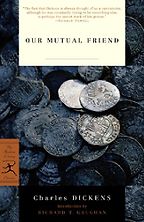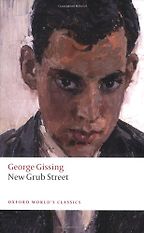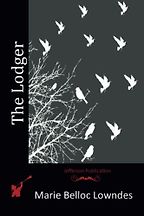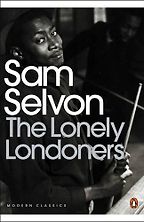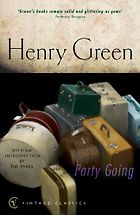You’ve chosen five novels. What is the link between London fog and London literature?
My view is that London fog defines London. It’s very difficult to think of London without its fog. In my book I talk about a lot of foreign travellers who come to London expecting to find it wreathed in fog all the time. That is, of course, an image they’ve picked up from various novelists—like Dickens—but it’s also an image they’ve carried with them. For me, London is summed up by its fog, and I think that’s true for many people as well.
Can you talk briefly about the atmospheric conditions that caused the London fog, and why and when it happened.
Queen Elizabeth I complains about the smoke of London. One of my big problems is how to define it. What’s the difference between smoke, fog, mist, London Particular, and London Ivy? Of course, these all amount to the same thing. Elizabeth I complains about the smoke, and London has a natural fog problem: it’s in a slight basin, it’s got a huge river running through it—in fact it had a couple of rivers running through it at that time—and it’s surrounded by marshland. It creates a natural damp atmosphere. When you load that up with coal particles from chimneys—either from industry or from the household fire—you then get a big problem, which is that green, yellow, black, greasy fog that sticks to your clothes, that makes your collar black, that can kill.
Why did it take so long for people to do something about it?
Campaigners were trying desperately to bring in clean air acts from the 1820s. And there were means to clean up the air, they did have access to smokeless fuel—but it was expensive. On continental Europe most householders would use closed stoves, which would combust fuel much more efficiently and would create less smoke. So the question, again, is why didn’t we import more closed-stoves? The answer is that we fell in love with our open, coal fire. People wanted to sit around real flames. That’s partly Dickens’s fault.
“November became traditionally the month for suicides because of people feeling depressed by the foggy weather.”
Politicians were desperately trying to bring in various kinds of legislation to combat the smokey air, but all the time they were thwarted. First by industrial interests; by people who ran their own industries and did not want to spend money training their stokers to be more efficient, or they didn’t want to spend any money converting their furnaces to be more efficient. And by about the 1850s, when London housing had been massively extended, they were pointing the finger at the householder and saying, “Why should we clean up our act when, actually, it’s not going to make any difference? Look at all the smoke coming out of the household chimney.”
Even in the 1950s, after the 1952 smog—which probably killed, conservatively, 4,000 people, possibly 12,000—you’d think there would be legislation to clean up the air. But Macmillan was very, very reluctant. His attitude was, “Surely if it’s important to people, they should be sorting it out themselves? Why should we force them to?” It was a very long, drawn-out exercise, of people who were willing to create laws to sort out the air and other people saying, “No, why should we bother?”
This mirrors the situation now. The air in London is still poisonous but, because we can’t see it, no-one is doing anything about it.
Yes. It’s actually quite depressing. It took almost 200 years to clean up the London air from—what I would call—a pea-souper and now we have this haze in London, which also is killing people. The mayor of London recently highlighted the fact that in 2010 about 9,500 people died from air-pollution-related illnesses. But this kind of haze has not caught writers’ imaginations, you don’t have it being portrayed in a fictional guise. I’m sure the fact that many writers and artists saw pea-soupers and wrote about them and painted them added to the move towards cleaning up the London air.
Dickens was the quintessential author of the London fog, and also a social campaigner. Your first book is his Our Mutual Friend. Why did you choose this book?
If I’m asked to choose any list of books, it would have to include Charles Dickens. He was the author I first seriously came to as a teenager. Every year, I always re-read a Dickens novel.
I’ve included Our Mutual Friend because it’s his last completed novel, but also because it has this wonderful, foggy scene at the start of Book III. It is as powerful as the opening pages of Bleak House—which would have been the obvious other candidate for a Dickens book on London fog. Dickens was a social campaigner, but he was also the reason why legislation did not get through. Dickens, whilst complaining about the London air quality, also supported the idea of the hearth being the central point of the family. He made us fall in love with our fire place. In fact, in this book, you have a scene in which Lizzie Hexam looks for her future in the fireplace, in the flames.
He’s on both sides of the argument, and I suspect he was clever enough to realise that.
You mention in your book how fog can be used in pulp fiction to create very obvious metaphors. But when you have a mixture of this very particular London fog and a genius like Dickens, what kind of metaphorical uses can be made of the fog?
In Bleak House he uses it to portray the fact that the law is obscuring truth, just as the fog is obscuring the buildings and people. In Our Mutual Friend, he looks at the way the City is being corrupted by money. We have this tour de force writing where he describes the London fog. It’s grey in the countryside and as it moves closer to the centre of the City of London it gets blacker and blacker. He’s showing how the London heart is getting blacker and blacker because it’s becoming corrupted by its love of money. The novel is about corruption caused by wealth.
How does Dickens’s use of the fog here influence later London literature?
I think every writer who comes to write a book about London, and to use London fog, is always referring back to Dickens, whether or not they decide to ignore him, or to use the way in which he employed London fog in a different way. Both are acknowledging Dickens’s power and his influence on later writings on London.
Your next book—one that was new to me—is New Grub Street by George Gissing. Who is Gissing, and how does this book use London fog?
It’s a shame Gissing has fallen out of favour. He’s an interesting writer. He had a miserable life, much of it his own fault. He spent most of it in poverty, mainly because he chose the wrong women, to put it mildly. He was at Manchester Grammar School and he stole for a prostitute and ended up spending some time in prison and then went to America. He foolishly came back and came to find her and started living with her, then she became an alcoholic and went mad. His second wife was equally a woman of fairly ill-repute, which meant he was constantly having to write to support his children and his rather chaotic domestic household.
Because he was writing so many novels, it’s fair to say many of them are patchy. But New Grub Street is one of his great novels. It is centred on writing and writers: the world of the hack writer versus the world of the serious writer. Gissing puts himself into this book, he wants to promote the idea that the only writing worth doing is one that might not sell, but that will actually be appreciated by the intelligent reader. In this novel, I think Reardon, one of the main characters, is actually Gissing. He’s desperately trying to produce a second novel of a quality that his first novel had reached. He has a friend—Milvain—who says, “No, I want to write a commercial novel. I want to just write commercially, to make money, even if it’s not great writing.”
In this novel, to come back to London fog, you have this terrific scene in the British Library where Marian Yule is being forced to do some research for her father. She’s a reluctant researcher, to say the least, and as she’s sitting there she’s feeling dispirited, she’s not happy at what she’s doing, she’s in love and the person she’s in love with doesn’t seem to notice her. And the fog creeps into the British Library. This is the old British Library Reading Room, if you’ve ever been there you’ll know it’s this dome shape, and Gissing describes it superbly. As the fog fills the room, she sees the people working there wandering around. She sees them as insects. It makes her feel more dispirited. She can smell, she can taste the fog and it adds to her clouded view of where her own life is going. I think the fog in this instance is about the traumatic pain of writing creatively.
You mention in your book that the fog could literally hamper creative writing if you couldn’t afford to light your room all day.
Yes, Henry James has a piece where he says, “It’s a foggy day, but actually I can shut the curtains, I can put the lamp on, and I can pretend to be writing even if I’m not!” Someone like Gissing, of course, could not afford the oil for his lamp, he could not afford coal for his fire—a fire that would of course add to the fog—and so for him fog is the end of his working day. For many people, it would mean they could not go out and sell their goods on the street because no-one would see them. For many people this disrupted their means of earning money. There are some wonderful stories about fog entering churches, and the vicar giving his sermon and no-one being able to see him. One story is from St. Paul’s, and he’s giving a sermon, rather ironically, on the light of the world. This is during the middle of the day: it’s day that’s turned to night.
This is something that’s taken up by a lot of pulp writers, I look at writers like Hay and Barr, who write stories about London being destroyed by its fogs, where all the inhabitants of London literally suffocate to death: life is over for them.
For how many days in the year—when it was at its worst—would the fog happen? Can you give an idea of what it would be like leaving your house in one of the worst fogs?
It was different from one year to the next. But the peak times for fogs were November, December, January. But you could still get a fog in April. They could last for up to five or six days. The really big smogs of 1873, 1952, they were five to six days. They could also be very patchy. You might be on one side of the street in an absolute black fog and you might cross over to the other side, which would be very clear. But the worst fogs were dense everywhere in London.
Even before you came out of your front door, the fog would seep in under the door, through the letterbox, and intrude into the household space. You’d be able to smell it. It would smell very sulphur-like, it would make you sneeze, and it could make you feel very unwell. It would certainly make you feel depressed. November became traditionally the month for suicides because of people feeling depressed by the weather, especially by the foggy weather. You’d go out and you’d put your scarf over your nose and your mouth, and you’d try as best you could to get down the street. But, remember, before electric lighting came in, you wouldn’t be able to see your way. You’d literally have to grab the railings and hold one after another so that you wouldn’t fall into the road. There were many accidents where people went into the road and were knocked over by a horse and carriage, or even walked into the Thames without realising it and drowned. It makes you realise how few Victorians could swim, but it also makes you realise how cluttered the Thames was, because you would be dragged under the ships.
Five Books interviews are expensive to produce. If you're enjoying this interview, please support us by donating a small amount.
It was very dangerous and the smell would have been phenomenal. It would have been very pungent and very greasy. You would feel the flakes of soot on your face, going down your throat, and many people died because they had weak lungs and they couldn’t discharge the particles from their lungs, so they would drown. At the 1873 cattle show in Islington many of the finely-bred cattle died, because their lungs were too well-bred to be strong enough to dispel these particles. Several animals died immediately on the spot. Many had to be put down. About sixty to seventy animals lost their lives. It was a massive loss to the owners of these very highly-prized cattle. Ironically, it was the cheaper animals who survived, because their straw bedding wasn’t cleaned out nearly as frequently. The urine from the straw would create a kind of antiseptic disinfectant to clean the air around them.
Your third book is Marie Belloc Lowndes’s The Lodger.
Marie Belloc Lowndes is the sister of Hilaire Belloc. She wrote many, many novels. The only one we really know of now is The Lodger. This is because it’s been filmed about four times. The most famous film is Hitchcock’s silent film from 1927, where Ivor Novello starred as the suspected murderer.
The book focusses on Mrs Bunting, who owns a house with her husband. They’re both ex-domestic servants and they’re struggling financially. They are desperate to keep their own house, but they haven’t been able to get many lodgers in. You see this from the opening scene, where there’s fog outside: they’ve closed their curtains to keep the heat in but also to hide from public gaze the fact they can hardly afford a fire. They are very fortunate because suddenly someone arrives to take the room. He’s a rather suspicious-looking man, called Sleuth. Very quickly, Mrs Bunting begins to think that he may be responsible for a series of murders of women that have been happening over the previous few months. They always happen on foggy nights. Her suspicions are raised because he always wants to go out in the fog, whereas most of us would want to stay in. The author is saying, “If you think someone is in your house who is responsible for these hideous crimes”—they’re loosely based on the Jack the Ripper murders—”what do you do?” Especially if you need his money.
Mrs Bunting thinks her lodger is a gentleman, so he can’t possibly be responsible for these hideous crimes. But when it becomes obvious that he probably is, she wants to protect him from going out into the fog, to stop him from committing these murders. She sees him as part of her household. Mr Bunting, who’s a bit slower on the uptake, starts putting two and two together eventually, but they can’t discuss their suspicions openly that their lodger, who in the newspapers is named ‘The Avenger,’ might actually be responsible for these crimes. In the end, he disappears mysteriously, leaving some money which they agree to leave to the Foundling Hospital as they don’t want to be sullied by these crimes.
The author was a reporter for W. T. Stead for the Pall Mall Gazette, which covered the Jack the Ripper crimes. The crimes were in the 1880s, and it seems that idea was always at the back of her mind. She was sitting at a dinner party and someone said, “I knew someone who was a butler who took in lodgers and he swore that one of his lodgers was Jack the Ripper.” So that’s where the story comes from.
Every page is wreathed with fog, it just drips with fog. She uses it to create this atmosphere of suspense, suspicion, murder, mystery. Of course, this has set up the template for any depiction of Jack the Ripper, and so we almost inevitably see him emerging from a fog. But in reality, none of his crimes took place on a foggy night, and on only one night was it raining! This is all manufactured in people’s imaginations, it has no basis in fact.
It was clear when Jack the Ripper was about. But on other foggy nights would it have been particularly dangerous for women?
Yes. Most women wouldn’t have gone out on a foggy night because they couldn’t possibly know who was round the corner. An unaccompanied women was always in danger of being seen as a woman of the street. Especially if she was from the middle and upper classes, a woman would not be seen unaccompanied. In some ways, the fog provides a cover for women who want to try to pretend they’re independent. There’s a wonderful scene in Henry James’s The Portrait of a Lady where Isabel Archer decides to walk back to her hotel room in a fog. This is seen in terms of her being bold, being courageous. James describes it in very mock-heroic terms. She feels she’s really taking a risk.
For other women, for other stories written about women in the fog, it provides them with a chance to perhaps meet the loves of their lives. Many couples might meet in a fog because they didn’t have a home where they could meet. A bench in a fog would conceal the fact that they were in love.
In some sense it was quite liberating for some women.
Absolutely!
You mention the book was made into a film, and that every page of the book drips with fog. Do you think that literature or cinema is better at depicting the fog?
When you read about it on the page, you can definitely get the reasons why the author is using the fog, what kinds of metaphors he or she is using the fog for. As I said with Dickens, it relates to corruption by money. In film it simply adds to the mystery and the suspense. It has now become an automatic signifier of a film or TV series set in Victorian London. Almost as soon as the gas lamps are shown on a foggy night, we know exactly where we are: a nineteenth-century street. I think authors use it in a much more complex way.
If we want to go to the visual medium, let’s look at Monet. He came over to paint London fog, and he did many many versions of it. About thirty three to thirty five canvasses still exist. He painted it in many different colours as he saw it as different each time. He has views of Charing Cross Bridge in the fog and there’s a purple sheen, or there’s a green, or there’s a yellow. He treats it in a much more visually complex way. Many English artists living in London just saw it as a nuisance. Monet and Whistler came over to paint the fog, whereas all the English artists where trying to get over to the Mediterranean to paint with clear skies.
Your next book is Henry Green’s Party Going. Tell me about this book.
Henry Green is a modernist writer, not very well known. He’s quite difficult, it’s not an easy read. He tends to play around a bit with sentences, he drops definite and indefinite articles. The book is about a group of what we would dub ‘bright young things,’ who are about to set off to go to a party that’s taking place on the continent. They have to get to Waterloo and catch the train. They set out on a particularly foggy day. We’re shown the different ways they get to the station. A very wealthy young woman decides it would be quicker for her to walk by herself—coming back to unaccompanied women—and almost as soon as she gets out into the fog she regrets her decision. She feels vulnerable, she feels nervous, she’s not used to being on her own. But once she’s stepped out into it she can’t go back because she can’t find her way back. That’s another example of a woman who feels very vulnerable but who actually thinks that she’s being very courageous by going into the fog.
“Most women wouldn’t have gone out on a foggy night because they couldn’t possibly know who was round the corner.”
The characters are well-drawn to an extent that we can see how different they all are, but they’re all part of the same set. They get to Waterloo and there are no trains going because of the fog. So they get stuck at Waterloo Station and they manage to get into the hotel and get a couple of rooms. They can be on their own and start the party by themselves. Of course, the rest of the people using the station—the working classes trying desperately to get home—are filling up the station. As they fill up the station the fog fills up the station and it becomes a very tense scene. These bright young things not only have tensions between themselves, two or three of the female characters love the same man, but there’s also the tension of the idea that this surge of people—partly symbolised by the fog—are actually going to intrude on their lives. Green is pointing out that the social class system is changing, there’s no longer going to be a role for these rather vapid, superficial, wealthy people who do nothing at all with their lives. He is suggesting that they’re going soon to be made to justify their existence. I don’t know how much Green thought that there would be a war but almost as soon as the book was published the Second World War was announced, which did dispense completely with that kind of class system.
If people were out in the fog, would there have been mixing between social classes?
Yes, and certainly for the Victorians that was one of the issues: that you could bump into someone who was not a member of your class. If you got completely lost, you might actually have to ask someone you wouldn’t normally want to talk to for directions. In The Forsyte Saga you see various characters getting lost in a fog and having to rely on working-class people to get them home. In other newspaper articles, people are taken home by blind people—ex-soldiers who lost their sight in the First World War—as they are the only ones who can find their way around. Henry Green is very aware of this mixing of classes within a foggy day. You can’t possibly keep yourself distinct when you’re lost in a fog.
You mentioned Henry Green’s experimentalist, modernist style, and elsewhere you talk about T. S. Eliot. How do modernist writers represent the fog, and how is that different to how Victorian writers represent it?
T. S. Eliot in The Waste Land sees the fog as part of the monotony of having to get to work, of being part of the working classes. They see it as part of a complex way of looking at classes, looking at life, how it’s dragging you down and not allowing you to be creative.
Your last book is Samuel Selvon’s The Lonely Londoners. Can you tell me about this writer and about how he describes the fog?
He came over to London from Trinidad in the 1950s, part of the Windrush immigration. He was among the first black, immigrant writers to be published in this country. The Lonely Londoners was published in 1956. He sees the fog as yet another reason why someone from the West Indies would feel this was an isolating place. Not only are they experiencing the coldness of the British people, who they’d been led to expect would welcome them—all they’re getting from these people is discrimination and suspicion—but also they’re in an environment where the fog settles on the day and you can’t even see the sun.
The opening sequence of The Lonely Londoners shows our main guide—called Moses, probably based on Selvon himself—having to get on a double-decker bus to go and meet a new arrival at Waterloo Station. He’s very reluctant to do this, but people write to him and ask him to meet people, and he feels that he’s got to do it. He’s really annoyed about it because he’s had to get out of his nice, warm bed, and the fog is delaying his journeys. Buses were as hampered by fog as any body else, often conductors would have to walk in front of the bus with a torch or handkerchief and guide it along the road because the driver simply couldn’t see in front of him. Moses blows his nose and on this white handkerchief you get these black particles that have filled up his nose. For me, that’s a sign of the way he has been made to feel that he’s contaminating this white society.
Selvon is not easy to read. He quite often dips into creolised English, but it creates a lot of atmosphere. Although these people are very miserable, they create a society amongst themselves. There are some parts of the book that are very funny. One of the immigrants goes to meet a cousin. Only the cousin in meant to have come, but in fact he has bought his aunt, his mother. At one point the aunt is chucking coal on the fire because she’s so cold, and another character says, “Why are you putting all that coal on the fire? You’re creating more of this fog!” She says, “What else am I meant to do to keep warm?” And of course, she’s showing the dilemma that many people in London experienced. You keep warm by putting coal on the fire, but by doing that you create more fog. It’s cyclical.
Some new-comers seem to have fallen in love with the evocative and strange nature of the London fog.
Yes, when the tourist board was trying to promote London as a place to visit they slightly cursed the fact they had this fog. But then when London’s air was cleaned up, tourists would come over and say, “Where’s the fog? I’d expected to see one and I’m very disappointed.” Nathaniel Hawthorne writes about the fog, in the later nineteenth century Chinese visitors are rather frightened by the fog when they’re part of it, but they also see it as rather beautiful, as rather mysterious. Because they don’t have to get to work every day, because they’re on holiday, they can just enjoy it through their hotel windows.
People still expect London to be wreathed in fog, tourists still complain about it.
This book is set during the great 1952 fog and, as you say, there was only one more, in 1962. To what extent does this—and contemporary writing—signify the emergence of a new London from the fog?
After the Second World War one of the reasons the Clean Air Act came into existence was because people wanted to see some kind of benefit from having fought a major war. There was a major fog in 1948, ’52, ’62. Suddenly people were saying, “This isn’t what we fought a war for. We want to have a cleaner environment, we don’t want to have to wash our net curtains every week because they’re getting filthy from fog. We actually want to see an improved London society.” In The L-Shaped Room, Lynn Reid Banks shows us her main character, Jane—who’s pregnant, alone, and poor—at one of her lowest moments when she thinks she’s having a miscarriage and she’s coming home from a heavy meal and gets completely lost in a fog. She has to hold lampposts to get from one point of the street to the next. She grabs a lamppost and is feeling so unwell she starts to fall down, clinging on for dear life, and she smells the urine from the dogs. There is a feeling that Londoners should want better than this, they should want a better environment for their children, and I think that’s why the 1956 clean Air Act came into being.
Five Books aims to keep its book recommendations and interviews up to date. If you are the interviewee and would like to update your choice of books (or even just what you say about them) please email us at [email protected]
